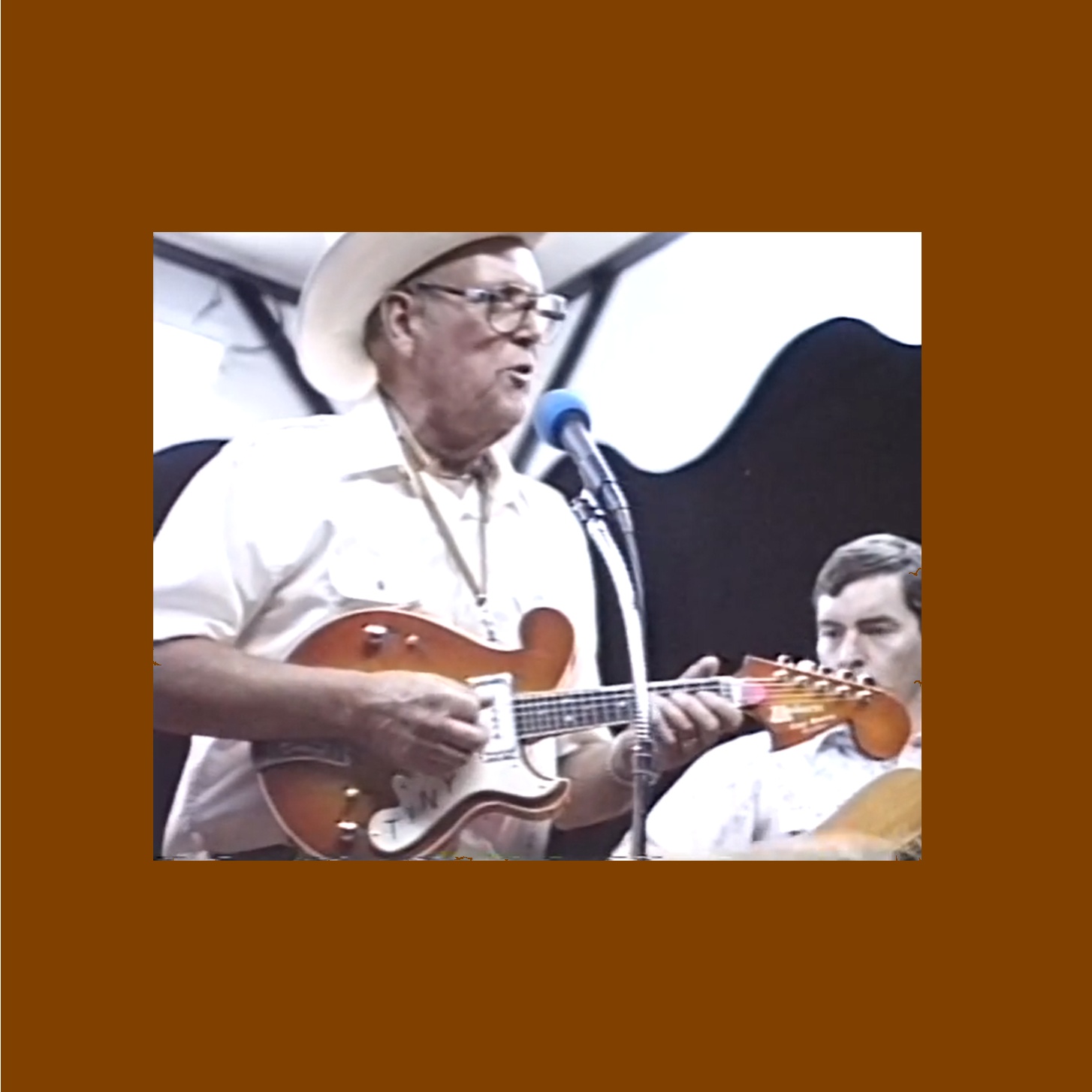
Musikalischer Stil
Western Swing
Land
USA
Instrument
Elektrische, 5-saitige Mandoline
Tiny Moore - Biografie (engl.)
Tiny Moore Bio (aus Mandolin World News 1/1978, Interview mit Dix Bruce)
Tiny Moore was born in Port Arthur, Texas in May 12, 1920 and began taking classical violin lessons at about age six. His mother taught piano occasionally and the two would play popular tunes ofthe day by reading sheet music. Unfortunately, his violin teacher found out about this recreational playing and became upset, directing him to not play popular songs.
He continued his classical training for three or four years and then gave up the violin until his mid-teens. By that time he had overcome the influence of his strictly classical training and once again began to play popular tunes. He began playing with friends and relatives at house parties and dances until, while listening to the radio, he heard a mandolin player named Leo Raley. At this point Tiny's interests switched from violin to mandolin and he began with an electric eight string.
Here began a succession of bands and musical associations that took him throughout Texas and Oklahoma as well as many parts of the southern United States. In the mid-forties Tiny Moore landed ajob with Bob Wills and the Texas Playboys. He traveled and recorded with the Wills Band for four years, eventually marrying Dean McKinney of the McKinney sisters, a musical duo that was part of the Wills Band.
Tiny tired of life on the road and finally settled in Sacramento in 1950 to manage Bob Wills'recreation center, Wills Point, He continued playing in the Wills Point house band, run by Bob's younger brother, Billy Jack Wills,
The fifties brought television, rock and roll, and hard times to the Wills organization, People were no longer turning out en masse to dance to Western Swing music. Bob Wills moved to Sacramento in the mid-fifties and began directing the Billy Jack Wills Band intending to take it on the road. Tiny Moore at this time had a home, wife, three children, and a dislike of clubs and the grind of the road. As a result of his desire to be with his family, Tiny chose to terminate his professional relationship with Bob Wills and began working as a jack of all trades for a local television station. At one point he hosted a children's show which included animal pets, among them a monkey named Anna Banana. Tiny's playing at this time was generally confined to local work on weekends.
In 1960 a labor dispute led to a strike at the television station. The union ended up losing the strike and members lost their jobs, Tiny among them. When his television job ended, he settled on the teaching profession and opened his own music store in 1962.
In 1970, Tiny was contacted by Merle Haggard to help record, along with other, Wills alumni, an album entitled A Tribute to the Best Damn Fiddler in the World. This led to a continuing association with Haggard as both a recording and performing artist. Haggard asked Tiny to join the band full time in 1973 and he stayed with Haggard until 1976. Tiny still performs occasionally with Haggard, most recently on NBC's special three hour country music show, Fifty Years of Country Music.
Tiny Moore's recordings with Bob Wills and Haggard are classics of swing mandolin. Often mistaken for electric guitar tone-wise, Tiny Moore's lines are uniquely mandolin inspired. He has also recorded and performed extensively on fiddle with both Wills and Haggard and often does session work with groups such as Asleep at the Wheel.
Today Tiny Moore concentrates his energy on his Sacramento music store, where he teaches guitar, fiddle, and mandolin, and often competes in northern California fiddle contests. His most recent project has been to develop and market, along with instrument maker Jay Roberts, a copy of his original early '50s Bigsby five string electric mandolin (see photos). Each new instrument is specially made by Roberts and checked by Tiny Moore.
Tiny Moore - Biografie (engl.)
Tiny Moore Bio (aus Mandolin World News 1/1978, Interview mit Dix Bruce)
Tiny Moore wurde am 12. Mai 1920 in Port Arthur, Texas, geboren und begann im Alter von etwa sechs Jahren mit klassischem Geigenunterricht. Seine Mutter unterrichtete gelegentlich Klavier, und die beiden spielten beliebte Melodien des Tages, indem sie Notenblätter lasen. Leider erfuhr sein Geigenlehrer von diesem Freizeitspiel und regte sich auf und wies ihn an, keine populären Lieder zu spielen.
Er setzte seine klassische Ausbildung drei oder vier Jahre lang fort und gab dann das Geigenspiel bis in seine Mitte des Teenageralters auf. Zu diesem Zeitpunkt hatte er den Einfluss seiner streng klassischen Ausbildung überwunden und begann wieder, populäre Melodien zu spielen. Er begann mit Freunden und Verwandten auf Hauspartys und Tanzveranstaltungen zu spielen, bis er beim Radiohören einen Mandolinenspieler names Leo Raley hörte .
Hier begann eine Reihe von Bands und Musikvereinen, die ihn durch ganz Texas und Oklahoma sowie in viele Teile des Südens der Vereinigten Staaten führten. Mitte der vierziger Jahre landete Tiny Moore bei Bob Wills und den Texas Playboys. Er reiste und nahm vier Jahre lang mit der Wills Band auf und heiratete schließlich Dean McKinney von den McKinney-Schwestern, einem Musikduo, das Teil der Wills Band war.
Tiny hatte das Leben auf der Straße satt und ließ sich schließlich 1950 in Sacramento nieder, um das Erholungszentrum von Bob Wills, Wills Point, zu leiten. Er spielte weiterhin in der Hausband von Wills Point, die von Bobs jüngerem Bruder Billy Jack Wills geleitet wurde.
Die fünfziger Jahre brachten Fernsehen, Rock and Roll und schwere Zeiten für die Wills-Organisation. Die Leute kamen nicht mehr in Massen, um zu westlicher Swing-Musik zu tanzen. Bob Wills zog Mitte der fünfziger Jahre nach Sacramento und begann, die Billy Jack Wills Band zu leiten, um sie auf Tour zu bringen. Tiny Moore hatte zu dieser Zeit ein Zuhause, eine Frau, drei Kinder und eine Abneigung gegen Clubs und Straßenlärm. Aufgrund seines Wunsches, bei seiner Familie zu sein, entschied sich Tiny, seine berufliche Beziehung zu Bob Wills zu beenden und begann, als Alleskönner für einen lokalen Fernsehsender zu arbeiten. Einmal moderierte er eine Kindershow mit Haustieren, darunter ein Affe namens Anna Banana. Tinys Spiel beschränkte sich zu dieser Zeit im Allgemeinen auf lokale Arbeiten am Wochenende.
1960 führte ein Arbeitskampf zu einem Streik beim Fernsehsender. Am Ende verlor die Gewerkschaft den Streik und die Mitglieder verloren ihre Jobs, darunter auch Tiny. Als sein Fernsehjob endete, entschied er sich für den Lehrerberuf und eröffnete 1962 sein eigenes Musikgeschäft.
1970 wurde Tiny von Merle Haggard kontaktiert, um zusammen mit anderen Wills-Alumni bei der Aufnahme eines Albums mit dem Titel A Tribute to the Best Damn Fiddler in the World zu helfen. Dies führte zu einer anhaltenden Verbindung mit Haggard sowohl als Aufnahme- als auch als Aufführungskünstler. Haggard bat Tiny 1973, der Band Vollzeit beizutreten, und er blieb bis 1976 bei Haggard. Tiny tritt immer noch gelegentlich mit Haggard auf, zuletzt in NBCs spezieller dreistündiger Country-Musikshow „Fifty Years of Country Music“.
Tiny Moores Aufnahmen mit Bob Wills und Haggard sind Klassiker der Swing-Mandoline. Tontechnisch oft mit E-Gitarren verwechselt, sind die Linien von Tiny Moore auf einzigartige Weise von der Mandoline inspiriert. Er hat auch viel Geige mit Wills und Haggard aufgenommen und gespielt und macht oft Session-Arbeit mit Gruppen wie Asleep at the Wheel.
Heute konzentriert Tiny Moore seine Energie auf seinen Musikladen in Sacramento, wo er Gitarre, Geige und Mandoline unterrichtet und oft an nordkalifornischen Geigenwettbewerben teilnimmt. Sein jüngstes Projekt bestand darin, zusammen mit dem Instrumentenbauer Jay Roberts eine Kopie seiner ursprünglichen fünfsaitigen elektrischen Bigsby-Mandoline aus den frühen 50er Jahren zu entwickeln und zu vermarkten. Jedes neue Instrument wird speziell von Roberts hergestellt und von Tiny Moore geprüft.
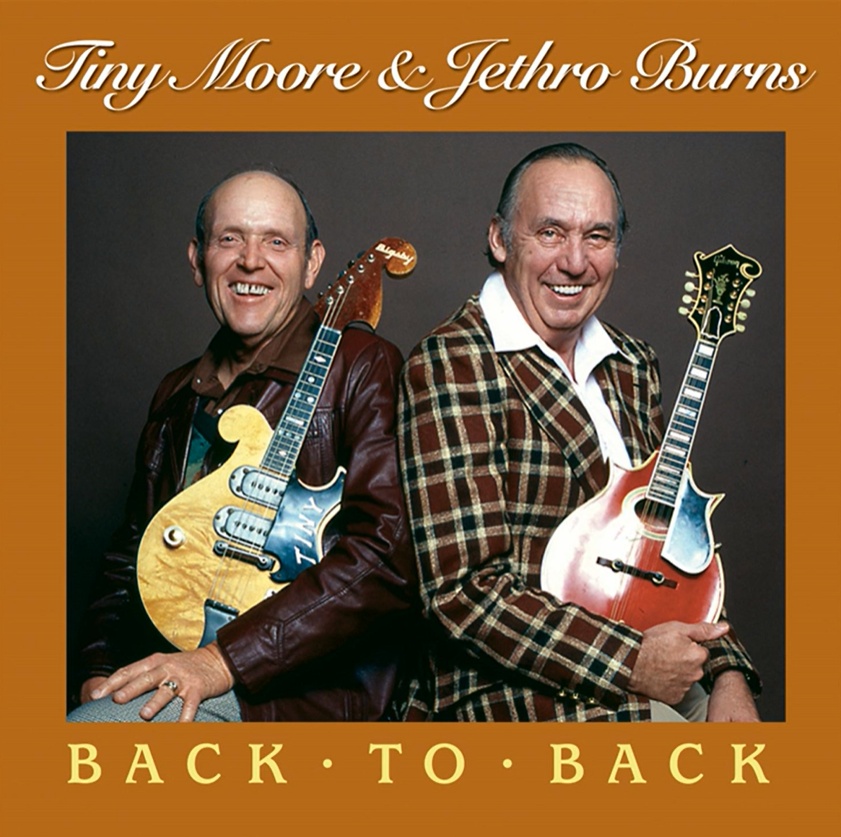
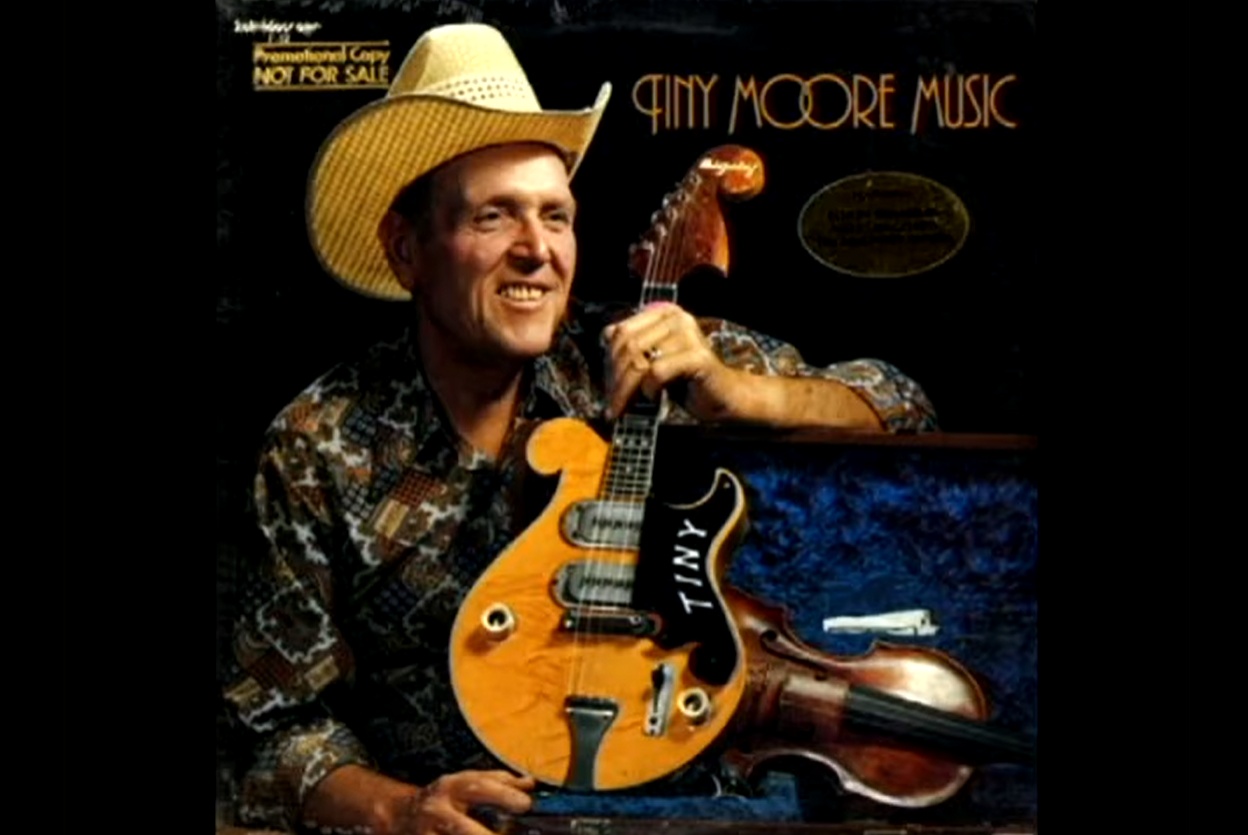
Tiny Moore - Mandolin World News 1/1978 Cover
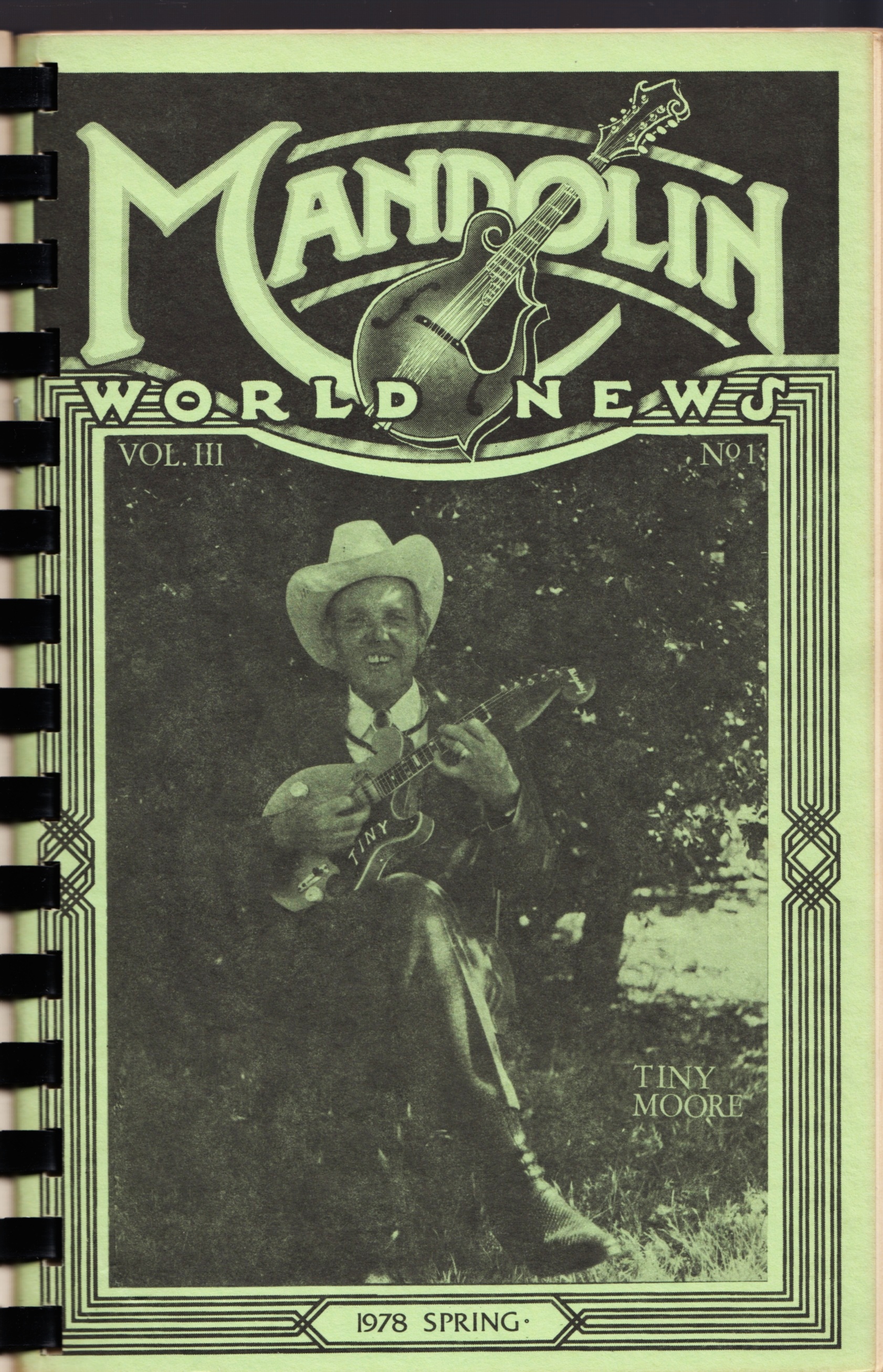
Bigsby Mandoline von Tiny Moore - Postkarte von Dix Bruce 1982
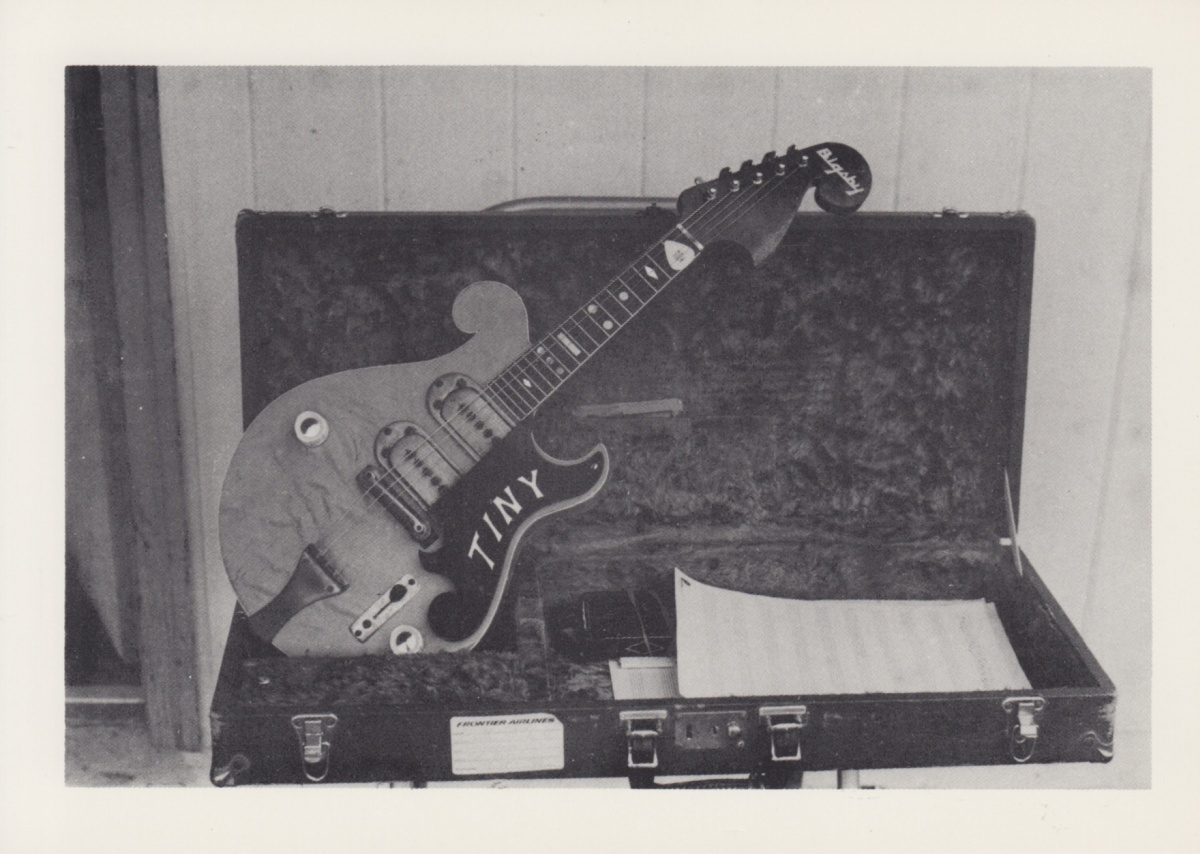
DB When did you get your Bigsby solid body?
TM: I was in Sacramento when 1 got the Bigsby, working with Billy Jack Wills' band, here in town and managing Wills Point, booking the band, and I'm not sure if I'd Seen one or not. But I knew Paul Bigshy made custom instruments and I just wanted one. So, one time we were playing Los Angeles and I got in touch with and ordered it. And it took me a year, year and a half to get it. I think that was the way it worked back then. I wanted to try the five strings, and that's the only way I knew to do it. This was about 1952.
DB: It has two pickups.
TM: Yes, he wound them himself. He's quite a guy. He wasn't a musician, all of his knowledge about making instruments and about electronics and the whole bit, he got in the library. Did research in the public library and he learned how to do all that. Of course he made some fantastic instruments.
DB: Is there a good five string electric available today?
TM: After I started to work with Haggard, several people asked me about the instrument I played. Some thought it was a small guitar and others just didn't know what it was. I talked to a fellow in Yuba City, California who made guitars etc. about making a couple of mandolins to see if' could peddle them. Jay Roberts is the builder's name. The Roberts Tiny Moore model is a copy of the original Bigsby that I have been playing since 1952. I used the Bigsby five string on all the Haggard records I made with him between 1973 and 1976.
DB Wann hast du deine Bigsby Solid Body bekommen?
TM: Ich war in Sacramento, als ich den Bigsby bekam, arbeitete mit der Band von Billy Jack Wills hier in der Stadt und leitete Wills Point, buchte die Band, und ich bin mir nicht sicher, ob ich einen gesehen hatte oder nicht. Aber ich wusste, dass Paul Bigshy maßgefertigte Instrumente herstellte, und ich wollte einfach eins. Einmal spielten wir also in Los Angeles und ich nahm Kontakt auf und bestellte es. Und ich brauchte ein Jahr, anderthalb Jahre, um es zu bekommen. Ich glaube, so hat es damals funktioniert. Ich wollte die fünf Saiten ausprobieren, und das war die einzige Möglichkeit, die ich kannte. Das war ungefähr 1952.
DB: Es hat zwei Tonabnehmer.
TM: Ja, er hat sie selbst verwundet. Er ist ein ziemlicher Typ. Er war kein Musiker, sein ganzes Wissen über den Instrumentenbau und über Elektronik und das ganze Zeug bekam er in der Bibliothek. Recherchierte in der öffentlichen Bibliothek und er lernte, wie man das alles macht. Natürlich baute er einige fantastische Instrumente.
DB: Gibt es heute eine gute fünfsaitige Elektrik?
TM: Nachdem ich anfing, mit Haggard zu arbeiten, fragten mich mehrere Leute nach dem Instrument, das ich spiele. Einige dachten, es sei eine kleine Gitarre und andere wussten einfach nicht, was es war. Ich sprach mit einem Kollegen in Yuba City, Kalifornien, der Gitarren usw. herstellte, um ein paar Mandolinen zu bauen, um zu sehen, ob man sie verkaufen könnte. Jay Roberts ist der Name des Erbauers. Das Roberts Tiny Moore-Modell ist eine Kopie des Original-Bigsby, das ich seit 1952 spiele. Ich habe die Bigsby-Fünfsaiter auf allen Haggard-Platten verwendet, die ich zwischen 1973 und 1976 mit ihm gemacht habe.
Cliff Bruner's Texas Wanderers It Makes No Difference Now
Im Interview in der Mandolin World News 1/1978 sagt Tiny Moore:
DB: When did you first hear mandolin played?
TM: The first I guess that I really noticed it was Leo Raley, a record that he made. Leo played in Houston, Texas with a very good territory band, they would book out of Houston and they had the daily radio program, this was the custom back in those days, to publicize their dances and shows, whatever they played. The first big record, "It Makes No Difference Now"
Leo Raley played the mandolin on it, in fact he kicked the tune off. Just a plain lead, but it was an electric mandolin and this intrigued me. And I really liked the sound of this. I got to listening to him on the radio and what have you, and became interested then. It had to have been thirty-eight or thirty nine.
***
DB: Wann haben Sie zum ersten Mal Mandoline gespielt gehört?
TM: Das erste, was mir wirklich aufgefallen ist, war Leo Raley, eine Platte, die er gemacht hat. Leo spielte in Houston, Texas, mit einer sehr guten Territorialband, sie buchten außerhalb von Houston und sie hatten das tägliche Radioprogramm, das war damals üblich, um ihre Tänze und Shows zu veröffentlichen, was auch immer sie spielten. Die erste große Platte „It Makes No Difference Now“
Leo Raley spielte die Mandoline darauf, tatsächlich hat er die Melodie angestimmt. Nur eine einfache Hauptrolle, aber es war eine elektrische Mandoline und das hat mich fasziniert. Und der Klang hat mir sehr gut gefallen. Ich hörte ihn im Radio und was auch immer und interessierte mich dann dafür. Es musste achtunddreißig oder neununddreißig gewesen sein.
Billy Jack Wills, Vance Terry, Tiny Moore 7 songs part 1
Billy Jack Wills and his Western Swing Band. 1952/54
Thanks to Alan Carner & Uncle Bob for saving these files. I used no noise reduction on these, just removed some clicks and set EQ.
Aus dem Interview in MWN 1/1978:
DB: How did you meet Bob Wills?
TM: Meeting Bob was kind of an unusual thing. He had played Port Arthur that night and this was on a Sunday night I think, and a drummer friend of mine , Richard Prine (who lives in Fresno now), and I were going up to Oklahoma to look for work. He was out of ajob and so was I. We were going to leave after the dance, we went out to the dance there in Port Arthur, big big crowd, and I knew one of the people in the Bob Wills band, I had worked with him in the shipyards in Houston, Junior Barnard. But I asked Junior if there was a chance of getting ajob with Bob and he said he was sure there wasn't, that Bob wasn't hiring anybody. So I didn't get to talk to Bob at all. So after the dance we loaded up Richard's car with his family and kids and got to Beaumont, Texas, and went on past this eating place where we usually ate and decided that we might ought to turn around and get a cup of coffee and a hamburger or something. So we went back and Tommy Duncan and Bob Wills and Billy Jack Wills, his younger brother, were in the restaurant eating. Richard knew Bob, he had met him, he got to talking to him and told him about me, that I played mandolin and Bob called me over and we talked a little while about what kind of music I played. He asked ifl had it with me and of course I did. I went out to the car and got the amplifier and mandolin and was just a little bit nervous, needless to say. And brought it in and the people who owned the restaurant let me put the amplifier up on the counter. They plugged it in in back ofthe counter, and I can still see us doing this, and I set on the stool and that'swhere my audition with Bob Wills was. Nobody playing accompaniment of any kind.
I think he'd ask me to play certain tunes and rd play them as best I knew how.
DB: What was your role in the band?
TM: When I first went to work with Bob it was strictly lead, strictly mandolin. But when I wasn't with the band but just a little while when one of the fiddle players lost his job and Bob usually used three fiddles in those days. So I said I could probably learn to play the harmony on those things, I never did do any of the lead stuff as far as the fiddle was concerned, strictly played the harmony with Joe Holly or whoever was the other fiddle player.
Sacramento 1952 - 1954 [1982] - Billy Jack Wills And His Western Swing Band Featuring Tiny Moore
Musicians:
・Billy Jack Wills (Drums, Vocals)
・Tiny Moore (E. Mandolin, Fiddle, Vocals)
・Kenny Lowery (Guitar)
・Vance Terry (Steel Guitar)
・Cotton Roberts (Bass, Fiddle)
・Dick McComb (Trumpet, Bass)
Recorded at Radio Station KFBK in Sacramento, California between 1952-1954.
Billy Jack Wills - Vance Terry - Tiny Moore part 2
Aus dem Interview in MWN 1/1978:
DB: Wie haben Sie Bob Wills kennengelernt?
TM: Bob zu treffen war irgendwie ungewöhnlich. Er hatte an diesem Abend in Port Arthur gespielt, und das war an einem Sonntagabend, glaube ich, und ein befreundeter Schlagzeuger, Richard Prine (der jetzt in Fresno lebt), und ich fuhren nach Oklahoma, um Arbeit zu suchen. Er war arbeitslos, und ich auch. Wir wollten nach dem Tanz gehen, wir gingen dort in Port Arthur zum Tanz, eine große Menge, und ich kannte einen der Leute in der Bob Wills-Band, ich hatte gearbeitet mit ihm in den Werften in Houston, Junior Barnard. Aber ich fragte Junior, ob es eine Chance gäbe, bei Bob einen Job zu bekommen, und er sagte, er sei sich sicher, dass es keine gäbe, dass Bob niemanden einstellen würde. Also kam ich überhaupt nicht dazu, mit Bob zu sprechen. Also beluden wir nach dem Tanz Richards Auto mit seiner Familie und seinen Kindern und fuhren nach Beaumont, Texas, und fuhren an diesem Imbiss vorbei, wo wir normalerweise aßen, und beschlossen, dass wir vielleicht umkehren und uns eine Tasse Kaffee und einen Hamburger holen sollten oder so. Also gingen wir zurück und Tommy Duncan und Bob Wills und Billy Jack Wills, sein jüngerer Bruder, waren im Restaurant essen. Richard kannte Bob, er hatte ihn getroffen, er kam mit ihm ins Gespräch und erzählte ihm von mir, dass ich Mandoline spielte, und Bob rief mich an und wir unterhielten uns eine Weile darüber, welche Art von Musik ich spielte. Er fragte, ob ich es dabei hätte, und natürlich hatte ich es. Ich ging zum Auto und holte den Verstärker und die Mandoline und war nur ein bisschen nervös, unnötig zu sagen. Und brachte es herein, und die Leute, denen das Restaurant gehörte, ließen mich den Verstärker auf die Theke stellen. Sie haben es hinten an der Theke angeschlossen, und ich kann uns immer noch dabei sehen, und ich habe mich auf den Hocker gesetzt, und dort war mein Vorsprechen mit Bob Wills. Niemand spielt irgendeine Art von Begleitung. Ich glaube, er bat mich, bestimmte Melodien zu spielen, und sie so gut wie möglich spielen.
DB: Was war deine Rolle in der Band?
TM: Als ich zum ersten Mal mit Bob zur Arbeit ging, war es ausschließlich Lead, ausschließlich Mandoline. Aber als ich nicht in der Band war, sondern nur eine kurze Weile, als einer der Geigenspieler seinen Job verlor und Bob damals normalerweise drei Geigen benutzte. Also sagte ich, ich könnte wahrscheinlich lernen, die Harmonien auf diesen Dingen zu spielen, ich habe nie irgendwelche Lead-Sachen gemacht, was die Geige anbelangt, ich spielte die Harmonie ausschließlich mit Joe Holly oder wer auch immer der andere Geigenspieler war.
Living Room Concert and Interview - "Tiny Moore: Feat. Tom Phillips and Martha Dean Moore," 1984
A Staff Pick from Archivist Kim Hayden!
"Tiny Moore! I'm a huge fan of classic country music and western swing, and Tiny Moore is a legend with local ties. He was a mandolin dynamo and fiddler who played with Bob Wills and Merle Haggard, and he had a long history working and living here in Sacramento. I love how this video starts with quiet tuning up and chatting, and then Tiny just starts effortlessly ripping it up! The interviews with Tiny are great, too. As a swing dancer, I love hearing about the dances he used to play."
Jethro Burns, Tiny Moore, Shamlin. Gimble ACL 1981
Jethro Burns and Tiny Moore - Back To Back
Music [1980] - Tiny Moore
Label: Kaleidoscope Records F-12
Format: Vinyl
Country: US
Released: 1980
For a full version:
Song List:
【00:00】A1 - Air Mail Special 3:30
【03:30】A2 - Don't Get Around Much Anymore 2:53
【06:24】A3 - I Surrender Dear 3:51
【10:19】A4 - Cattle In The Cane 2:17
【12:36】A5 - Fat Boy Rag 3:03
【Muted due to copyright issues. Sorry!】【15:40】A6 - Maiden's Prayer 2:38
【18:25】B1 - Stumbling 3:00
【21:24】B2 - Things Aren't Funny Anymore 4:00
【25:25】B3 - Well Dunn 3:30
【28:58】B4 - Honeymoon Waltz 2:54
【31:52】B5 - Herman's Rag 2:31
【34:26】B6 - Life's Greatest Treasure 3:06
Musicians:
・Tiny Moore (E. Mandolin, Mandolin, Fiddle)
・McKinney Sisters (Vocals)
